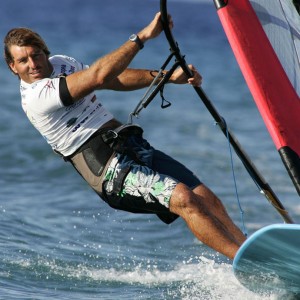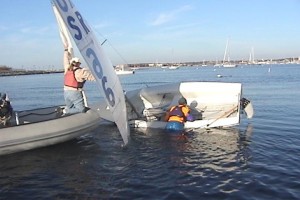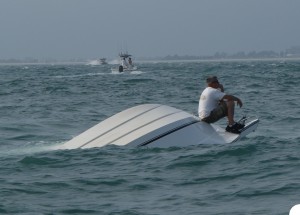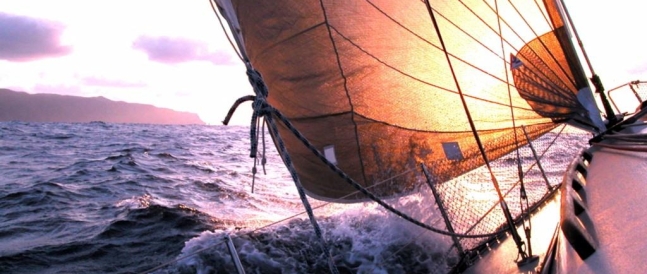The Power of Intention
When a sailor takes a boat out on a journey, there’s usually an aiming point, a destination, a course that has been charted. Only if the sailor is very lucky can one follow the wind directly to that destination; having the “wind at your back” is not a typical situation. More often than not, the sailor has to hold the boat on course despite the fact that the wind and the tide might be pulling it in a different direction. This ability to hold the boat on course, despite the pull of opposing forces, is the power of intention.
 Intention is a formidable force in relationships of all sorts, including bodywork and Touch Practice. It is also invisible, underestimated, essential and often neglected. The practice of approaching another person while asking yourself, “what is my intention here?” is a very powerful clarifying practice that can help “keep the boat on course” in many different situations.
Intention is a formidable force in relationships of all sorts, including bodywork and Touch Practice. It is also invisible, underestimated, essential and often neglected. The practice of approaching another person while asking yourself, “what is my intention here?” is a very powerful clarifying practice that can help “keep the boat on course” in many different situations.
Intention is not quite the same thing as will-power, but they’re closely related. We’re not talking about the brute force required to stick to a diet–for example, to walk past the potato chip aisle without picking up any bags. Rather, intention points to the original aiming point–in this example, perhaps, to lose five pounds.
 Intention often has to be coupled with the practice of beginning again, because while we may have the intention to sail the boat to a certain place, we might make mistakes. We might get off course, or we might lack the physical or emotional strength to hold the course. If that happens, intention allows us to make a course correction.
Intention often has to be coupled with the practice of beginning again, because while we may have the intention to sail the boat to a certain place, we might make mistakes. We might get off course, or we might lack the physical or emotional strength to hold the course. If that happens, intention allows us to make a course correction.
The most quizzical aspect of intention is that it is invisible to others; no one will know your intention but you. It is impossible to know what another person’s intention is, and most efforts to identify someone else’s intention fall short of mental health.
The attempt to diagnose someone else’s intention is called interpersonal attribution. You can never really know why someone does or says something. If you ask them, they could lie. Or they could tell you truthfully, but they themselves could be unaware of the reasons behind an action. They might have conflicting intentions: someone who tried to “help” you consciously might also have an unconscious piece of themselves that wanted to get a “dig” in at the same time. People very often act from more than one intention, and not all of the intentions are conscious, and some of them might be polar opposites!
 So asking the question, “what was his intention” is almost always an invitation to psychopathology, whereas asking the question “what is my intention” is almost always clarifying. If you get curious about the power of intention from reading this blog, do everyone in your world a favor, and limit your curiosity to yourself. You’re not going to get inside anyone else’s head, no matter how hard you try. But spending time inside your own will make your world a better place. Men who live their lives with a specific, clear intention often change the world.
So asking the question, “what was his intention” is almost always an invitation to psychopathology, whereas asking the question “what is my intention” is almost always clarifying. If you get curious about the power of intention from reading this blog, do everyone in your world a favor, and limit your curiosity to yourself. You’re not going to get inside anyone else’s head, no matter how hard you try. But spending time inside your own will make your world a better place. Men who live their lives with a specific, clear intention often change the world.
The simple practice of going into a situation asking yourself, “ok, what is my intention here?” is one I have found very powerful. During the morning tea time with which we celebrate our marriage, we will often conclude by asking each other, “do you have an intention for today?” It can often be something very simple: “to take the time to eat healthily” or “to be kind” or “to make sure I get to the gym” or “to try to be aware of my emotions.” It sets the course for the boat, rather than heading out into the day with the sails flapping, allowing the boat to be driven by the wind rather than by the pilot.
The truth about sailing is, as I’ve said, the wind is almost always blowing in a direction other than the direction you want to sail. Part of the skill of sailing is being able to sail against the wind, sometimes nearly head-on, “close hauled,” proceeding in a certain direction despite the fact that all forces are against you.
I can guarantee you that on those days when I set my intention to be kind, or to get to the gym, or to eat healthily, the wind starts up the minute I leave the house, and it does not blow me directly to the gym. Some days it seems to be blowing bags of potato chips directly at me.
 In Touch Practice, these winds can come in the forces of erotic energy, or attraction, or aversion, or emotion, or sexual desire, or any one of another varieties. I always set an intention towards the person I am about to hold, usually before I meet them, and I typically combine that with washing my hands, lighting a candle and offering a prayer. It is part of a ritual that I do to try to come at Touch Practice clean and empty, and with a set intention.
In Touch Practice, these winds can come in the forces of erotic energy, or attraction, or aversion, or emotion, or sexual desire, or any one of another varieties. I always set an intention towards the person I am about to hold, usually before I meet them, and I typically combine that with washing my hands, lighting a candle and offering a prayer. It is part of a ritual that I do to try to come at Touch Practice clean and empty, and with a set intention.
 My intention usually includes a desire to do no harm, a desire to offer safe and sacred space for someone, and to be a force of good in their life. Sometimes the intention varies when I get to know someone and start to understand what their own goals are for the work. One of the reasons I took myself through the exercise of writing a formal mission statement for Touch Practice is to clarify my intentions.
My intention usually includes a desire to do no harm, a desire to offer safe and sacred space for someone, and to be a force of good in their life. Sometimes the intention varies when I get to know someone and start to understand what their own goals are for the work. One of the reasons I took myself through the exercise of writing a formal mission statement for Touch Practice is to clarify my intentions.
And in the middle of any Touch Practice encounter, we can expect the wind and the tide to pull on the boat. The intention of creating sacred space for someone will be pushed around by “I really like this person” or “I am not so attracted to this person” or “gosh why am I so horny today” or “I have to remember to grocery shop later” or “I do/don’t like the way he smells” or any one of a hundred other winds. Intention holds the boat on course. Intention keeps bringing us back to the question, “what is my intention in holding this man? What am I attempting to do or create here? Where am I aiming the boat?”
 No one can or will know your intention but you. Sometimes in friendship we intend to do something helpful, but it blows up; what was intended to be helpful ends up being hurtful. Sometimes we read things into each others’ words or behaviors that weren’t there, or sometimes, because we’re not clear, we proceed from a mix of intentions, a desire to help and hurt at the same time, or a desire to avoid and engage at the same time. All we can do is clarify. “What is my intention?” If the boat is off course, we adjust course. Sometimes we fall into the water and have to start all over from the beginning.
No one can or will know your intention but you. Sometimes in friendship we intend to do something helpful, but it blows up; what was intended to be helpful ends up being hurtful. Sometimes we read things into each others’ words or behaviors that weren’t there, or sometimes, because we’re not clear, we proceed from a mix of intentions, a desire to help and hurt at the same time, or a desire to avoid and engage at the same time. All we can do is clarify. “What is my intention?” If the boat is off course, we adjust course. Sometimes we fall into the water and have to start all over from the beginning.
If you find this interesting, I invite you this week to the practice of asking “what is my intention?” Perhaps over your morning coffee, before you sail your boat off to the office, set one intention for the day. Maybe it is “my intention is to put myself first today.” Or it might be “my intention is to be as gentle as possible today” or “my intention is to firmly stand up for myself today.” You can clarify an intention before you meet a friend for dinner; you can set an intention before disciplining a child (“my intention is to offer loving correction here”) or even before a workout or grocery shopping.
Imagine what driving would be like if every driver on the highway set an intention before getting in the car, something like “may every person get safely and quickly to where they are going” or “my intention is to contribute to an orderly flow of traffic.” It’d be quite a different highway.
I wish you an intentional week! Thanks for reading.
Have thoughts you’d like to share?
Touch Practice is a sacred practice for me, and part of that is keeping confidences sacred. While a name and e-mail address are required to post a comment, feel free to use just your first name, or a pseudonym if you wish. Your e-mail address will never be seen by or shared with anyone. It is used to prevent spam and inappropriate comments from appearing in the blog. I’d really like to hear from you!














I am so impressed by the concept of non sexual touch, I am in much need of the healing that comes by touch. Any groups or seminar in the Houston Texas area?
Rafael, thanks for your note. I have had a good number of touch practice partners in the Houston area. If there is interest in a workshop, then even if I can get a minimum of 8-12 men together I am happy to bring Touch Practice to your location. Please feel free to e-mail me and I’d be glad to talk to you about how we build local workshops.
Kevin:
I would like to get in “touch” with any of those contacts you mentioned in Houston. If there anyway you could forward then my email so thy can contact me or viceversa.
Thanks
PS: This a great thing you are leading, thanks
Hey Rafael: unfortunately, I don’t have anyone I can refer you to in Houston. Some day, perhaps! I hope!